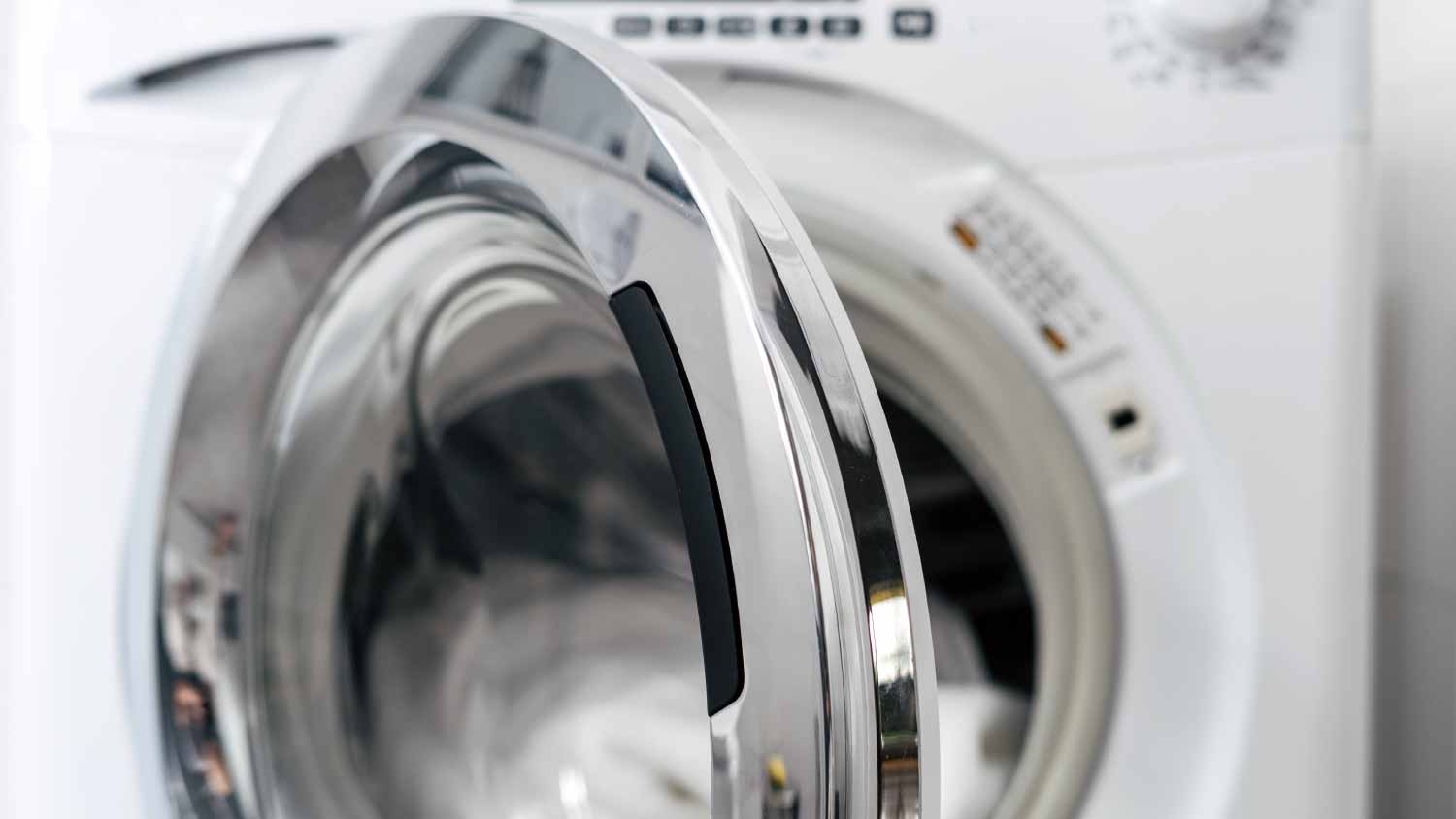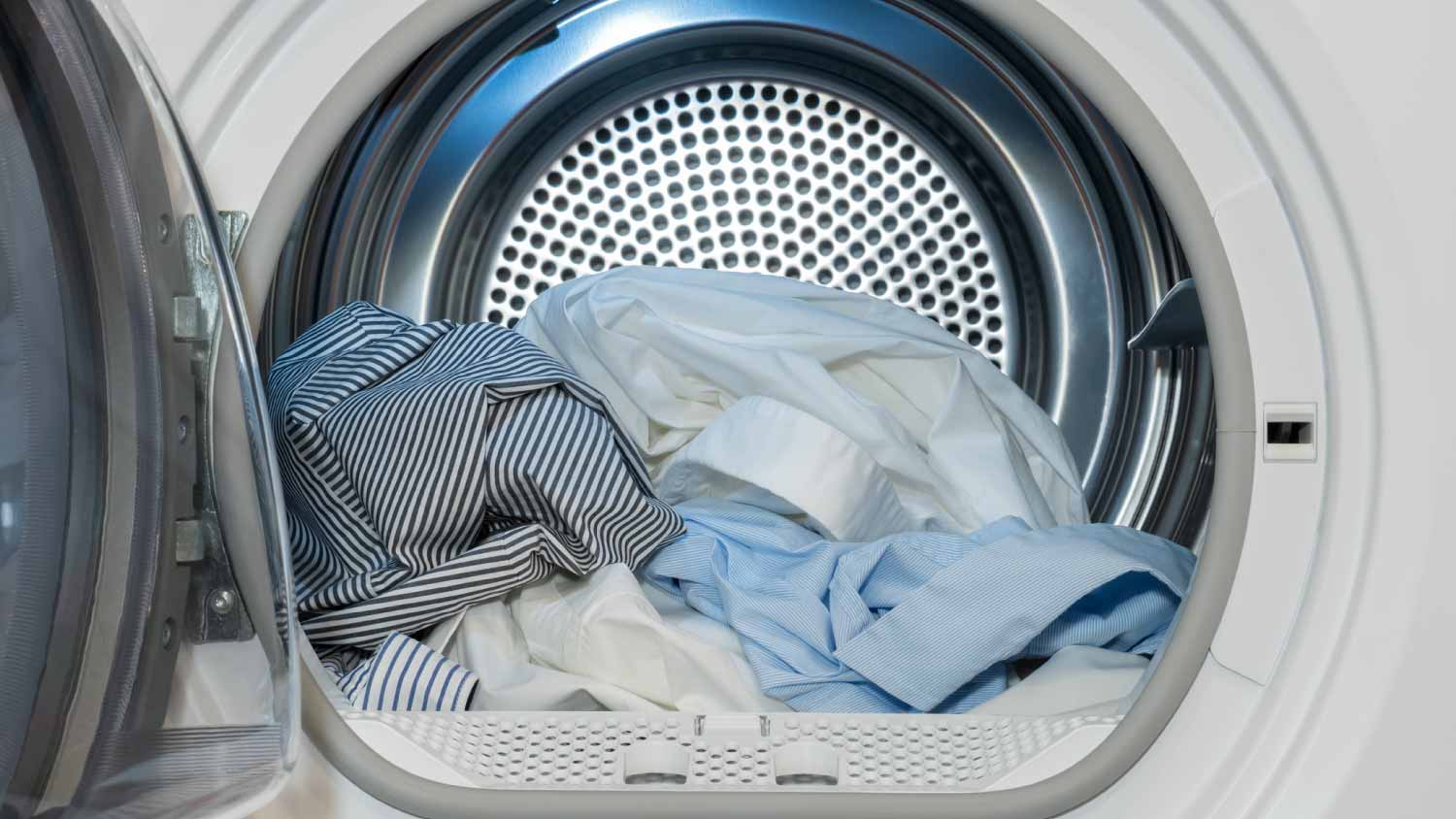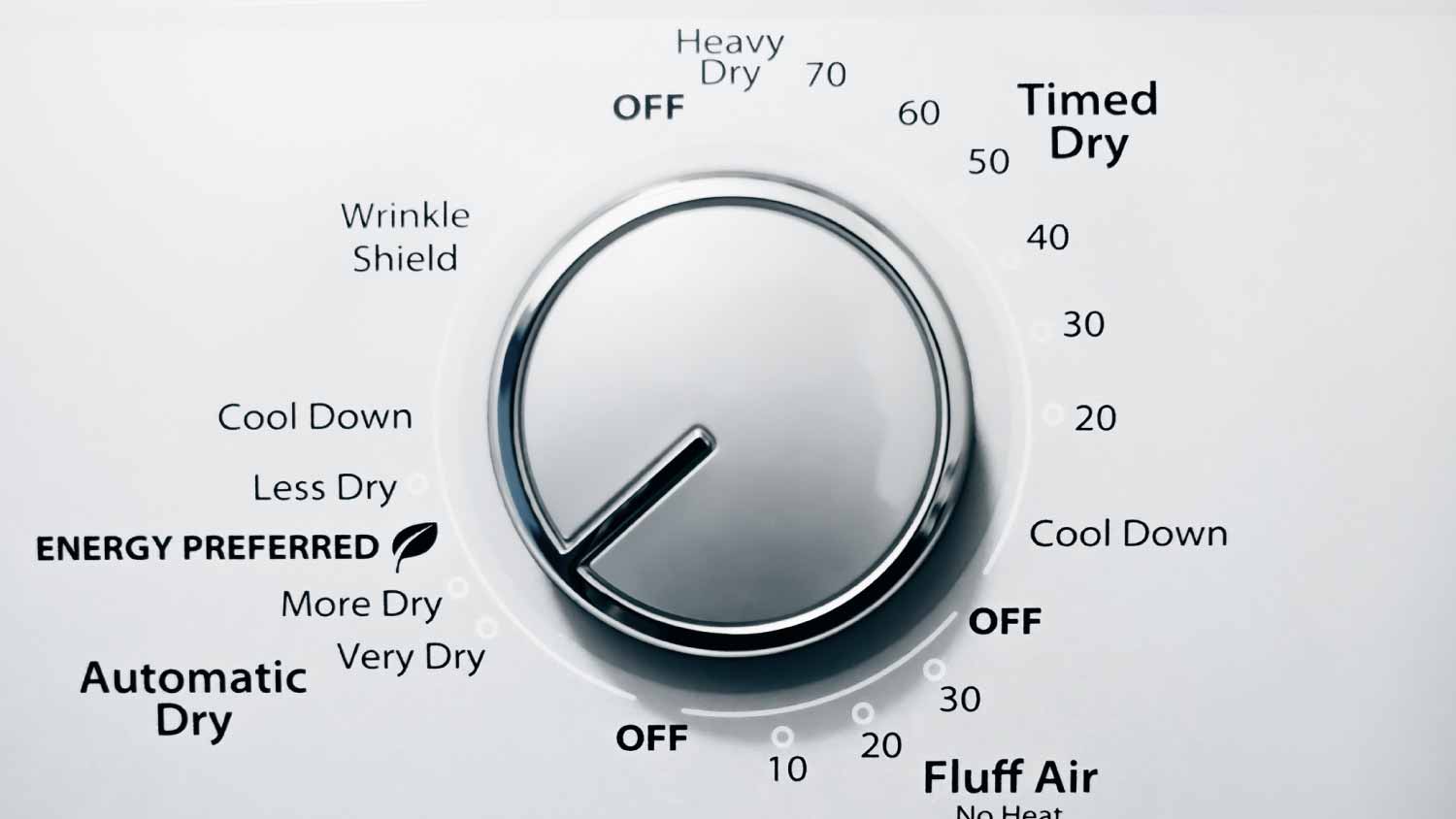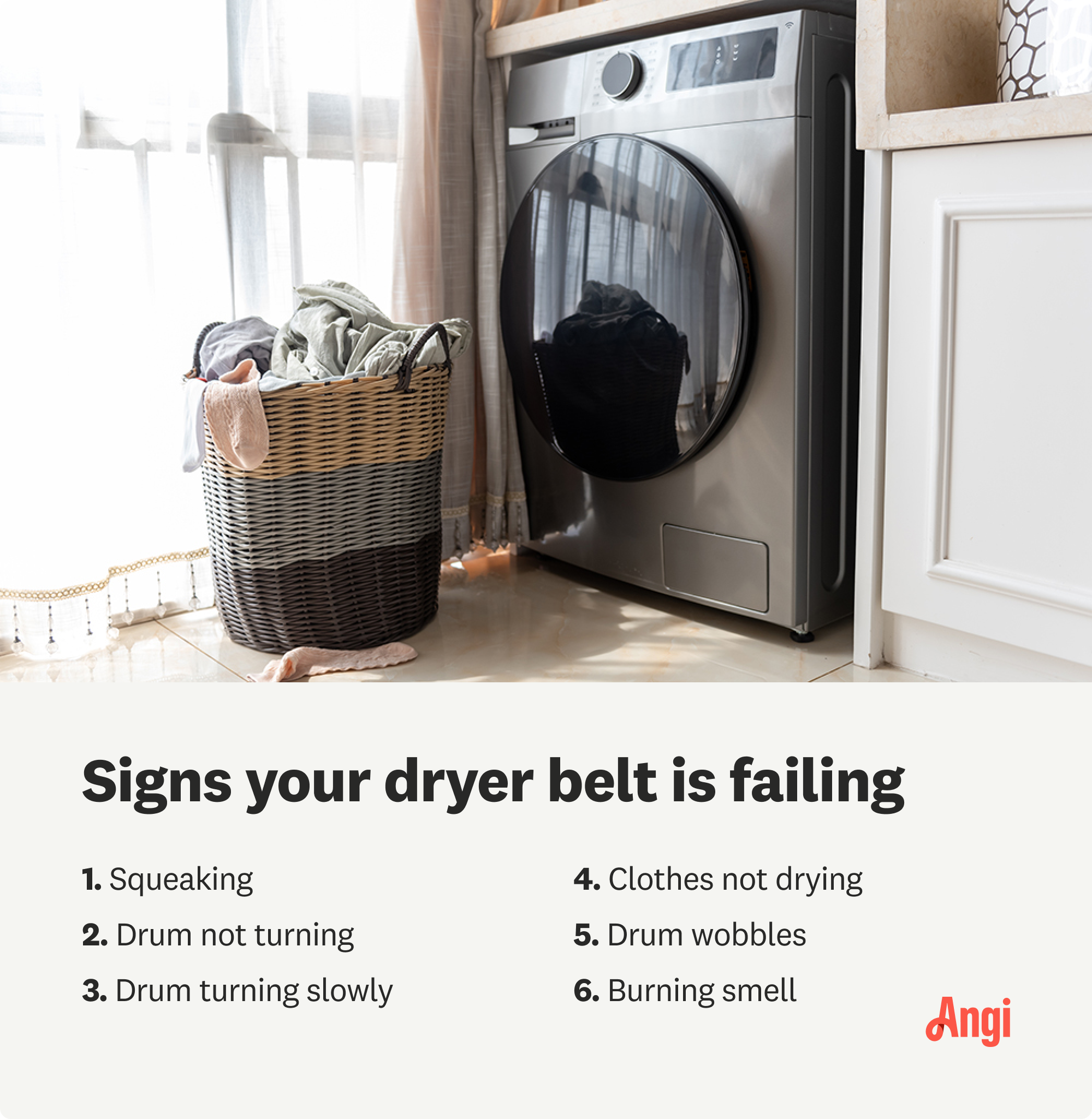
Is your washer on the fritz? We’re breaking down common washing machine repair costs to help you prepare to fix it while sticking to your budget.
Find out what's going on so you don't have to hang your clothes out to dry


A dryer that won't start can sometimes be a quick fix.
The problem can stem from the door, the power source, or a worn-out part.
Some dryer fixes are best left to the pros and shouldn't be tackled on your own.
Yesterday, it was working fine, but today, the dryer won't start. That can be particularly bad news if you've got a large load of wet laundry on your hands. With a bit of troubleshooting, you may be able to find the reason why your dryer won't start. While you can fix some issues yourself, others are best left to a local dryer repair service.
Discover the most common reasons for a dryer that doesn't start and what you can do about them.

Sometimes, you think you've fully closed the dryer door, but it's not completely latched. The issue could be that you didn't use enough force and the door didn't click shut. A piece of clothing might be trapped in the door, keeping it from fully closing.
If the dryer isn't starting, check the door. Remove any clothing from the area and press on the door until you hear a click. That may be enough to solve the problem.
It could be that you're closing the door all the way, but the door switch itself isn't working. The door switch usually makes a sound when it's activated. If you close the door and don't hear a "click," that can mean that the switch is broken.
If your dryer has a light inside the drum and a window in the door, take a look inside after you've closed the door. If the light stays on, that's another sign that the switch isn't activating. You can also try opening the door and pressing on the switch with your finger to see if doing so turns off the light.
If the dryer’s door switch is malfunctioning, you may be able to fix it yourself if you have basic electrical skills and the right tools. Unplug the dryer, access the door switch (by removing the control panel or door frame), and test it with a multimeter. If the switch is faulty, you can replace it with a new one following the manufacturer's instructions.
However, if you're uncomfortable working with electrical components or if the switch is difficult to access, call a professional. A dryer repair company can replace a faulty door switch for you in a snap.

Too much weight from clothes can prevent the washer’s drum from spinning properly. Dryers can only handle so much laundry at a time. When you overload the washer, the motor will struggle to rotate the drum. This added motor strain can trigger a safety mechanism that prevents the dryer from starting.
An overloaded dryer can also overheat from restricted airflow. Proper airflow is crucial to keeping the internal components at a safe temperature. Overheating can activate thermal fuses or safety switches that shut down the dryer to prevent fires or further damage.
Whether you have a gas or electric dryer, it needs electricity to run. A dryer may occasionally not start because of an issue with the power source. It could be that the dryer has become unplugged or the power cord is worn out. Always check the power to confirm the dryer is fully plugged in and there aren't any issues with the cord.
If the cord is frayed, it may be time to replace it. When the prongs at the end of the cord are discolored, that can be a sign that the dryer is using too much power and overheating.
The issue could also come from the outlet itself. If the dryer's plugged in and the cord is damage-free, try plugging a small appliance into the outlet to see if it works. You can also use a multimeter to test the outlet.
Additionally, a failed terminal block disrupts the electrical connection between the power supply and the dryer's internal components, cutting off the electrical current required for the dryer to operate. Finally, the power issue could stem from a blown fuse or tripped circuit breaker. Take a look at your fuse box to see if the circuit or fuse connected to your dryer has flipped or blown.
When it comes to appliances, you have to consider the extent of the issue. If it is minor problems or something that simply requires maintenance, then it might be more cost-effective to do a repair. If the failure is a major component of the appliance, then it will likely be easier and more affordable in the long run to just replace it and get peace of mind.

When the child lock feature is activated on a dryer, it disables the control panel to prevent accidental operation. This safety feature ensures that pressing any buttons or turning knobs will not work. It effectively locks down all of your dryer functions. Even if the dryer is plugged in and all other components are functioning properly, the machine will not start or respond to any inputs if the child lock is on.
The power issue could come from inside the dryer itself. Modern dryers have thermal fuses, which keep them from overheating. The thermal fuse can blow out when the dryer's vents are clogged.
You can DIY fix a blown thermal fuse on a clothes dryer if you're comfortable working with electrical components. Unplug the dryer, locate the thermal fuse (found on the blower housing or vent duct behind the dryer’s rear panel), and test it with a multimeter. If it’s faulty, replace it with a new one following the manufacturer's instructions.
Replacing the fuse and cleaning your dryer's vents are all that's required to fix this problem.

The control board manages all the dryer's functions and operations, processing input from the user interface and sending signals to various dryer components, such as the motor, heating element, and sensors. If the control board malfunctions or fails, these signals can’t transmit.
Without a functioning control board, the dryer can't receive instructions to initiate the drying cycle, adjust temperatures, or control the timing of different phases of the drying process. The control board acts as the brain of the dryer, and when compromised, the dryer loses its ability to operate. Symptoms of a failed control board may include an unresponsive control panel, failure to start, or erratic behavior during operation.

The drive belt connects the motor to the drum, enabling the drum to spin and tumble the clothes during the drying cycle. When the belt is worn out or broken, the motor may run, but the drum will remain stationary, preventing the dryer from performing its primary function.
Many dryers have a belt switch or sensor that detects if the belt is broken. This safety feature can prevent the dryer from starting to avoid further damage or overheating.
The dryer belt is one of the more common components that can break due to its constant use. Over time, the belt can become frayed, stretched, or snap entirely.
Regular maintenance and periodic inspections can help identify wear and tear early, allowing for timely replacement before the belt fails. On average, a dryer belt replacement costs range between $60 and $190.
Your dryer's thermostat controls the temperature and works to keep the machine from getting too hot. If the thermostat stops working properly, the dryer can overheat, trip the thermal fuse and refuse to power back on.
A faulty thermostat can also make a dryer think it's hotter than it is. Most dryers have safety mechanisms that keep them from running when the temperature is above a certain amount. If you suspect there's a problem with the thermostat, a repair professional can confirm it and make the fix.

The on button, or start switch, on a dryer can wear out with time. If you load the dryer, set the timer and press the on button, and nothing happens, that's a good sign that something is up. You can test the button using a multimeter or call in a professional to test and replace it for you.
A dryer timer controls the length of the drying cycle by regulating the power supply to the motor and heating elements. The timer ensures that the dryer runs for the set duration and shuts off automatically once the cycle is complete.
If the timer is malfunctioning or broken, it can’t signal the start or end of the cycle. This break in communication can prevent your dryer from working.
A broken timer also poses a safety hazard because it could fail to turn the dryer off at the appropriate time, potentially leading to overheating. Dryers rely on precise timing to prevent excessive heat build-up and ensure safe operation. If the timer isn't functioning correctly, the dryer’s safety mechanisms may prevent it from turning on to avoid these risks.
The drive motor is responsible for turning the dryer's drum, tumbling your clothes and helping them dry. When the motor gets blocked by lint or small objects, it can get stuck or overheat. When that happens, the motor won't be able to turn the drum and the dryer won't run.
If you press the start button and the dryer starts humming, but not running, that's usually a sign that there's a problem with the motor. Unplugging the dryer and checking the motor for blockages can fix the issue. If it doesn't, consider calling a repair pro to take a look.
Knowing how to clean your dryer vents can help prevent any problems with the drive motor.
Depending on the reason why your dryer won't start, you may be able to troubleshoot the issue yourself. If the door is open, the dryer is too full, or the child lock is on, you can easily fix the problem to keep your dryer operational. A power issue where the cord has come unplugged is also an easy fix.
However, most other dryer issues including a broken belt or faulty thermostat will require hiring a local dryer repair technician. Dryers have electrical and mechanical components that can pose a safety risk if not fixed by a professional. On average, dryer repair costs range between $100 and $430.
Unless you have extensive experience in this dryer repair, it's best to leave it up to the professionals. Not only will they be able to diagnose the issue, but they'll work to resolve it safely and ensure optimal operation.
From average costs to expert advice, get all the answers you need to get your job done.

Is your washer on the fritz? We’re breaking down common washing machine repair costs to help you prepare to fix it while sticking to your budget.

Broken glass stove tops are not only unsightly; they can also be dangerous. Use this guide to learn how much glass stove top replacements cost based on factors like size and type.

Range hoods come in various styles and help keep your kitchen clear of odors, smoke, and grease. Here’s how much it costs to install a range hood by type.

How do wood stove fans work, and why do you need one? Learn how to boost your home’s heating efficiency with our comprehensive guide.

Is your washing machine not draining? This is often an easy problem to fix. Keep reading to learn how to drain a washing machine.

Learning how to install a washing machine standpipe drain is not the most complicated task, but you need to follow the steps precisely to ensure nothing leaks or breaks.